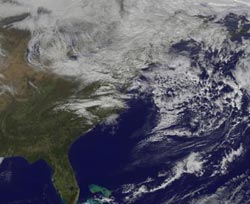Satellite still shows Sandy's remnant clouds over eastern Canada and the northeastern US

This visible image from NOAA's GOES-13 satellite shows the remnant clouds from Sandy still linger over the Great Lakes, east to New England and north into Canada at 1:31 p.m. EDT on Nov. 2, 2012.<br><br>Credit: NASA GOES Project<br>
The National Weather Service map for Nov. 2, 2012 showed two areas of low pressure over eastern Canada, near Quebec.
That's where the remnants of Sandy are located and the storm's massive cloud cover continues to linger over a large area. That low pressure area is associated with Sandy's remnants.
A visible image from NOAA's GOES-13 satellite at 1:31 p.m. EDT on Nov. 2, 2012 showed the remnant clouds from Sandy still linger over the Great Lakes east to New England.
In Canada, Sandy's clouds stretch from Newfoundland and Labrador west over Quebec, Ottawa and Toronto. The GOES image was created by NASA's GOES Project at the NASA Goddard Space Flight Center, Greenbelt, Md.
By Monday, Nov. 6, the National Weather Service map projects that the low pressure area associated with Sandy's remnants will be offshore.
Media Contact
More Information:
http://www.nasa.govAll latest news from the category: Earth Sciences
Earth Sciences (also referred to as Geosciences), which deals with basic issues surrounding our planet, plays a vital role in the area of energy and raw materials supply.
Earth Sciences comprises subjects such as geology, geography, geological informatics, paleontology, mineralogy, petrography, crystallography, geophysics, geodesy, glaciology, cartography, photogrammetry, meteorology and seismology, early-warning systems, earthquake research and polar research.
Newest articles

A universal framework for spatial biology
SpatialData is a freely accessible tool to unify and integrate data from different omics technologies accounting for spatial information, which can provide holistic insights into health and disease. Biological processes…

How complex biological processes arise
A $20 million grant from the U.S. National Science Foundation (NSF) will support the establishment and operation of the National Synthesis Center for Emergence in the Molecular and Cellular Sciences (NCEMS) at…

Airborne single-photon lidar system achieves high-resolution 3D imaging
Compact, low-power system opens doors for photon-efficient drone and satellite-based environmental monitoring and mapping. Researchers have developed a compact and lightweight single-photon airborne lidar system that can acquire high-resolution 3D…





















